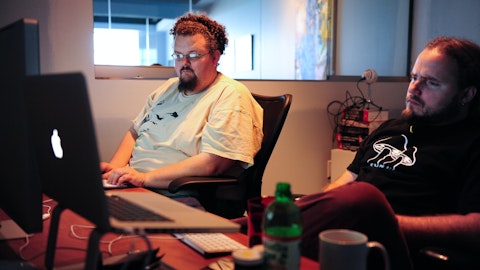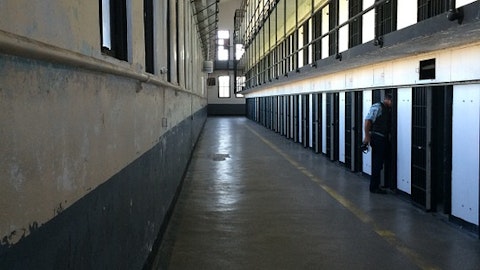Seth Seifman: I was wondering maybe if you could talk a little bit about the ’23 Omnibus and kind of how that’s set up your expectations for the growth that should be coming in the Dynetics programs, particularly in the 2024 time frame?
Roger Krone: Yeah. Okay. Those are — you two, I would say, lightly linked subject. So let me talk through them and I’ll have Chris clean up after me when I make a mistake. But given the year and what’s going on, on the Hill, I think the Omnibus is about the best we can expect. And my hope and our plan is McCarthy, the President find a way to raise the debt ceiling long before the June date. And the debt is really paying for past years for authorizations and appropriations that have already been made, commitments that the country has been made, and we’re just funding the government. And that will probably fund it we’re hoping a little bit higher than the 2023 levels. I think we can count on that. And as you know, it’s always a discussion between defense and nondefense, and if we raise defense, then there’s a group of elected officials who want to raise the non-defense budget at the equal amount.
And that may tamp down a little bit of the raise in defense, but we’re coming off such a robust defense budget this year that I think we will all do okay. Now how does that roll into Dynetics? And again, if you were down in Huntsville and I’ll describe a little bit what you would have seen is a lot of productions that are in low rate initial stage of the program, where we’re building the first age preproduction or production units that will be followed in ’24 by a fairly aggressive ramp and significant production. We’re talking instead of one a month, one a week, two a week. And we could go through the different programs. I won’t do that now. Those monies are pretty much already authorized and appropriate, okay? Not in every case, I won’t go program by program, but if we get an omnibus then the ramp that we talked about in December is certain because these are programs of records that will be fully funded.
I won’t go into all the scenarios if there’s a debt ceiling or there’s a reason and all the things that the government could do, which is certainly within the realm of possible. We think the high probability is they’ll get an omnibus. It will have some growth in it. There may be a Ukraine supplemental depending upon how it goes and it certainly doesn’t appear to be lessening. So they may cover those expenses with the supplemental as they have done in the past. And then our production ramps in ’24, which are again, we think we’re very pleased. I think they’re very attractive. Those would be fully funded and we would see significant growth in Dynetics in ’24, and I’ll let Chris add to that.
Chris Cage: Not a lot to add. I mean, Seth, obviously, you can tell from Roger’s comments, which were mostly focused towards the future €˜24 we felt really good about how ’23 Omnibus came out, and our Leidos affairs team does an excellent job, and we clearly were making sure members understood the importance of some of our key programs. And we like the way we came out. You don’t get everything funded at the level that you’d like. But on balance, we thought we came out exceptionally well and well protected with key programs and that sets us up nicely for this year.
Seth Seifman: Cool. Excellent. Okay. I’ll leave it there for this morning. Thanks very much.
Chris Cage: Thank you.
Operator: Next question coming from the line of Ken Herbert with RBC Capital Markets. Please proceed with your questions.
Kenneth Herbert: Yes. Hi. Good morning.
Chris Cage: Hey. Good morning.
Kenneth Herbert: Maybe for Chris or Roger, you did a really nice job sort of sequentially first half to second half in ’22 on the margins. And I know you went through a number of items around your physical footprint, some insourcing, maybe some labor savings. But it also sounds like from the guide that in your comments that you’re obviously not going to keep all of this. My question would be, how do you view sort of incremental sort of corporate level cost opportunities as you look at the business into ’23? And how is the discussion with the customer in terms of how much you’re able to keep, what’s necessary to be competitive and win share in the marketplace? I mean how do you view these dynamics into ’23? And where are the incremental opportunities at the corporate level from the cost side?
Chris Cage: Well, Ken, let me get started. Roger might pile on. So first of all, very proud of the team, second half of the year as a team, we really rallied and showed we’re capable of on the cost control, margin improvement front. And quite honestly, that was despite the fact that we had some program areas where we could have done better. And so I think that gives us some confidence and momentum going into ’23. Now a couple of things to keep in mind. The Health Group overall for the year finished still above 17% on margins. right? So fourth quarter was definitely more in line with what expectations are going forward. But earlier in the year, there was still some stronger performance from caseload and QTC and other things that drove that higher.
So that will still moderate down a bit, but we do intend to capture the savings and the margin upside that we’ve been able to realize in other parts of the business. And we’re not done in Defense Solutions and in civil for sure. And as we build our pricing, we have a rigorous process with our competitive intelligence team to kind of keep us in tune with where we need to be on a price to win front. We factor that in and making sure that we can remain competitive while still trying to capture some of the margin upside. So the guidance is balanced for next year. And again, there’s momentum there. I wouldn’t say there’s any super low-hanging fruit on the cost reduction side because we do focus on that continuously. But there’s still more that we can do, and we’re focused on hitting that 10.5% long-term margin target or greater by 2024.
Roger Krone: Yeah. I don’t have much to add, Ken. I’ll make a couple of points that I’m not sure we get the food stomp. So taxes and interest which I wish I could control, but I don’t. That’s like a $0.20 headwind on EPS. And we’ll do all we can, and we’ve got a great tax department, and we’ll see if we can mitigate that. Unfortunately, interest rates are up and the way we manage our balance sheet, we’re in the market, we’re always replacing expiring debt instruments, and so that creates a headwind. But really, our philosophy is if we can grow revenue faster than we grow our indirect costs, then we get better every year. And so growing the top line has really helped us control costs. We had really good growth in the second half.
Again, we expect continuous growth for the rest of this year. And then the challenge is to control costs below revenue growth, but we’ve found — like we have some costs that grow with the number of people right? And so one of our thoughts are we’ve had a business that was somewhat dependent on people to grow, right? And we’ve talked in the past about, well, we want a little bit more product mix. We wanted a little bit more diversity in our portfolio. Part of that is so that we can grow nonlinear with people — and so if we have — we get to the ramp in Dynetics where we’re building more products, we can leverage our terrific workforce, but it’s not one to one, and that allows us to grow faster than our indirect rates, and you can think about HR and benefits and all the things, the training programs that we have with our people.
So that’s just kind of our philosophy. And I think Chris did a good job of saying, we got fixed price and cost plus. And I’m sure you know how the mechanics are about what we have to give back based upon the contract type.
Kenneth Herbert: Great. I’ll stop there and pass it back. Thanks, Roger. Thanks, Chris.





